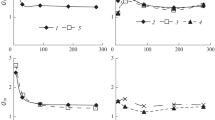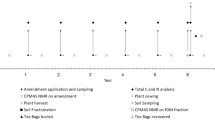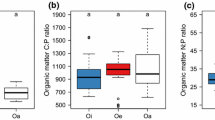Abstract
The decomposition and mineralization of various plant residues (oak and aspen leaves, pine needles, small branches and thin roots of trees, aboveground biomass and roots of meadow grasses, aboveground biomass and roots of clover, and straw and roots of barley) were investigated in the laboratory experiments by quantitative measurement of produced C–CO2. The plant residues were mixed with vermiculite or gray forest soil (Greyzemic Phaeozems Albic) and incubated under constant temperature and moisture conditions. After a year of incubation, 25–67% of Corg in plant residues were mineralized. Oak leaves, aboveground mass of meadow grasses, and aboveground mass and roots of clover were characterized by a three-pool structure of organic matter with moderate (0.1 > k1 > 0.01 day–1), slow (0.01 > k2 > 0.001 day–1), and very slow (k3 < 0.001 day–1) mineralization rates, while the other types of plant residues had only a two-pool structure with slow and very slow mineralization rates. An opposite relationship between the decomposition rate and the C : N ratio in the plant residues was found. Poorly decomposable types of plant residues were the main source for particulate organic matter (CPOM) in the soil, while highly decomposable types were the main source for microbial biomass (Cmic). The content of potentially mineralizable organic matter in the soil with plant residues correlated positively with CPOM and with Cmic.


Similar content being viewed by others
REFERENCES
V. N. Kudeyarov, “Soil and biogenic carbon dioxide sink in the territory of Russia: an analytical review,” Eurasian Soil Sci. 51, 599–612 (2018). https://doi.org/10.1134/S1064229318060091
A. A. Larionova, A. K. Kvitkina, S. S. Bykhovets, V. O. Lopes de Gerenyu, Yu. G. Kolyagin, and V. V. Kaganov, “Effect of nitrogen on mineralization and humification of forest litters in model experiment,” Lesovedenie, No. 2, 128–139 (2017).
A. A. Larionova, A. N. Maltseva, V. O. Lopes de Gerenyu, A. K. Kvitkina, S. S. Bykhovets, B. N. Zolotareva, and V. N. Kudeyarov, “Effect of temperature and moisture on the mineralization and humification of leaf litter in a model incubation experiment,” Eurasian Soil Sci. 50, 422–431 (2017). https://doi.org/10.1134/S1064229317020089
A. N. Mal’tseva, B. N. Zolotareva, and D. L. Pinskii, “Transformation of corn plant residues in loamy and sandy substrates,” Eurasian Soil Sci. 47, 466–477 (2014). https://doi.org/10.1134/S1064229314050147
D. L. Pinskii, A. N. Maltseva, B. N. Zolotareva, and E. D. Dmitrieva, “Transformation kinetics of corn and clover residues in mineral substrates of different composition,” Eurasian Soil Sci. 50, 681–687 (2017). https://doi.org/10.1134/S1064229317060096
V. M. Semenov, “Formation of extra nitrogen in fertilized soils and its role in the plant nutrition,” Agrokhimiya, No. 8, 5–12 (1999).
V. M. Semenov, A. S. Tulina, N. A. Semenova, and L. A. Ivannikova, “Humification and nonhumification pathways of the organic matter stabilization in soil: a review”, Eurasian Soil Sci. 46, 355–368 (2013). https://doi.org/10.1134/S106422931304011X
V. M. Semenov, L. A. Ivannikova, T. V. Kuznetsova, A. S. Tulina, and V. N. Kudeyarov, “Kinetic analysis of the decomposition and mineralization of plant residues in gray forest soil,” Eurasian Soil Sci. 34, 503–511 (2001).
V. M. Semenov, L. A. Ivannikova, T. V. Kuznetsova, and N. A. Semenova, “The role of plant biomass in the formation of the active pool of soil organic matter,” Eurasian Soil Sci. 37, 1196–1204 (2004).
M. V. Semenov, E. V. Stolnikova, N. D. Ananyeva, and K. V. Ivashchenko, “Structure of the microbial community in soil catena of the right bank of the Oka River,” Biol. Bull. (Moscow), 40, 266–274 (2013). https://doi.org/10.1134/S1062359013030084
S. Ya. Trofimov, A. S. Lazarev, and A. D. Fokin, “Mineralization of organic-matter labile fragments in the humus-accumulative horizon of soddy-podzolic soil,” Eurasian Soil Sci. 45, 1110–1119 (2012).
E. C. Adair, W. J. Parton, S. J. Del Grosso, W. L. Silver, M. E. Harmon, S. A. Hall, I. C. Burke, and S. C. Hart, “Simple three-pool model accurately describes patterns of long-term litter decomposition in diverse climates,” Global Change Biol. 14 (11), 2636–2660 (2008). https://doi.org/10.1111/j.1365-2486.2008.01674.x
A. Bani, S. Pioli, M. Ventura, P. Panzacchi, L. Borruso, R. Tognetti, G. Tonon, and L. Brusetti, “The role of microbial community in the decomposition of leaf litter and deadwood,” Appl. Soil Ecol. 126, 75–84 (2018). https://doi.org/10.1016/j.apsoil.2018.02.017
Y. M. Bar-On, R. Phillips, and R. Milo, “The biomass distribution on Earth,” Proc. Natl. Acad. Sci. U.S.A. 115 (25), 6506–6511 (2018). https://doi.org/10.1073/pnas.1711842115
P. Baruya, World Forest and Agricultural Crop Residue Resources for Cofiring (IEA Clean Coal Centre, London, 2015).
B. Berg and C. McClaugherty, Plant Litter: Decomposition, Humus Formation, Carbon Sequestration, 3rd ed. (Springer-Verlag, Berlin, 2014). https://doi.org/10.1007/978-3-642-38821-7
M. A. Bradford, B. Berg, D. S. Maynard, W. R. Wieder, and S. A. Wood, “Understanding the dominant controls on litter decomposition,” J. Ecol. 104, 229–238 (2016). https://doi.org/10.1111/1365-2745.12507
R. G. Burns, J. L. DeForest, J. Marxsen, R. L. Sinsabaugh, M. E. Stromberger, M. D. Wallenstein, M. N. Weintraub, and A. Zoppini, “Soil enzymes in a changing environment: current knowledge and future directions,” Soil Biol. Biochem. 58, 216–234 (2013). https://doi.org/10.1016/j.soilbio.2012.11.009
C. A. Cambardella and E. T. Elliott, “Particulate soil organic-matter changes across a grassland cultivation sequence,” Soil Sci. Soc. Am. J. 56 (3), 777–783 (1992). https://doi.org/10.2136/sssaj1992.03615995005600030017x
M. J. Castellano, K. E. Mueller, D. C. Olk, J. E. Sawyer, and J. Six, “Integrating plant litter quality, soil organic matter stabilization, and the carbon saturation concept,” Global Change Biol. 21 (9), 3200–3209 (2015). https://doi.org/10.1111/gcb.12982
W. K. Cornwell, J. H. C. Cornelissen, K. Amatangelo, E. Dorrepaal, V. T. Eviner, O. Godoy, S. E. Hobbie, B. Hoorens, H. Kurokawa, N. Pérez-Harguindeguy, H. M. Quested, L. S. Santiago, D. A. Wardle, I. J. Wright, R. Aerts, et al., “Plant species traits are the predominant control on litter decomposition rates within biomes worldwide,” Ecol. Lett. 11, 1065–1071 (2008). https://doi.org/10.1111/j.1461-0248.2008.01219.x
M. F. Cotrufo, J. L. Soong, A. J. Horton, E. E. Campbell, M. L. Haddix, D. H. Wall, and W. J. Parton, “Formation of soil organic matter via biochemical and physical pathways of litter mass loss,” Nat. Geosci. 8, 776–779 (2015). https://doi.org/10.1038/NGEO2520
M. F. Cotrufo, M. D. Wallenstein, C. M. Boot, K. Denef, and E. Paul, “The Microbial Efficiency-Matrix Stabilization (MEMS) framework integrates plant litter decomposition with soil organic matter stabilization: do labile plant inputs form stable soil organic matter?” Global Change Biol. 19 (4), 988–995 (2013). https://doi.org/10.1111/gcb.12113
K.-H. Erb, T. Kastner, C. Plutzar, A. L. S. Bais, N. Carvalhais, T. Fetzel, S. Gingrich, H. Haberl, C. Lauk, M. Niedertscheider, J. Pongratz, M. Thurner, and S. Luyssaert, “Unexpectedly large impact of forest management and grazing on global vegetation biomass,” Nature 553, 73–76 (2018). https://doi.org/10.1038/nature25138
C. Fortunel, E. Garnier, R. Joffre, E. Kazakou, H. Quested, K. Grigulis, S. Lavorel, P. Ansquer, H. Castro, P. Cruz, J. Doležal, O. Eriksson, H. Freitas, C. Golodets, C. Jouany, et al., “Leaf traits capture the effects of land use changes and climate on litter decomposability of grasslands across Europe,” Ecology 90 (3), 598–611 (2009). https://doi.org/10.1890/08-0418.1
G. T. Freschet, W. K. Cornwell, D. A. Wardle, T. G. Elumeeva, W. Liu, B. G. Jackson, V. G. Onipchenko, N. A. Soudzilovskaia, J. Tao, and J. H. C. Cornelissen, “Linking litter decomposition of above- and below-ground organs to plant–soil feedbacks worldwide,” J. Ecol. 101, 943–952 (2013). https://doi.org/10.1111/1365-2745.12092
K. Hakala, M. Kontturi, and K. Pahkala, “Field biomass as global energy source,” Agric. Food Sci. 18 (3–4), 347–365 (2009).
G. Incerti, G. Bonanomi, F. Giannino, F. Carteni, R. Spaccini, P. Mazzei, A. Piccolo, and S. Mazzoleni, “OMDY: a new model of organic matter decomposition based on biomolecular content as assessed by 13C‑CPM-AS-NMR,” Plant Soil 411 (1–2), 377–394 (2017). https://doi.org/10.1007/s11104-016-3039-2
M. Knorr, S. D. Frey, and P. S. Curtis, “Nitrogen additions and litter decomposition: a meta-analysis,” Ecology 86 (12), 3252–3257 (2005). https://doi.org/10.1890/05-0150
Y. Kuzyakov, J. K. Friedel, and K. Stahr, “Review of mechanisms and quantification of priming effects,” Soil Biol. Biochem. 32, 1485–1498 (2000). https://doi.org/10.1016/S0038-0717(00)00084-5
R. Lal, “World crop residues production and implications of its use as a biofuel,” Environ. Int. 31 (4), 575–584 (2005). https://doi.org/10.1016/j.envint.2004.09.005
J. Lehmann and M. Kleber, “The contentious nature of soil organic matter,” Nature 528, 60–68 (2015). https://doi.org/10.1038/nature16069
S. Manzoni and A. Porporato, “Soil carbon and nitrogen mineralization: theory and models across scales,” Soil Biol. Biochem. 41 (7), 1355–1379 (2009). https://doi.org/10.1016/j.soilbio.2009.02.031
Y. Pan, R. A. Birdsey, J. Fang, R. Houghton, P. E. Kauppi, W. A. Kurz, O. L. Phillips, A. Shvidenko, S. L. Lewis, J. G. Canadell, P. Ciais, R. B. Jackson, S. W. Pacala, A. D. McGuire, S. Piao, et al., “A large and persistent carbon sink in the World’s forests,” Science 333 (6045), 988–993 (2011). https://doi.org/10.1126/science.1201609
I. C. Prentice, G. D. Farquhar, M. J. R. Fasham, M. L. Goulden, M. Heimann, V. J. Jaramillo, H. S. Kheshgi, C. LeQuéré, R. J. Scholes, and D. W. R. Wallace, “The carbon cycle and atmospheric carbon dioxide,” in Climate Change 2001: The Scientific Basis, Ed. by J. T. Houghton, (Cambridge University Press, Cambridge, 2001), pp. 183–237.
C. E. Prescott, “Litter decomposition: what controls it and how can we alter it to sequester more carbon in forest soils?” Biogeochemistry 101, 133–149 (2010). https://doi.org/10.1007/s10533-010-9439-0
E. W. Sulzman, J. B. Brant, R. D. Bowden, and K. Lajtha, “Contribution of aboveground litter, belowground litter, and rhizosphere respiration to total soil CO2 efflux in an old growth coniferous forest,” Biogeochemistry 73, 231–256 (2005). https://doi.org/10.1007/s10533-004-7314-6
L. Sun, M. Teramoto, N. Liang, T. Yazaki, and T. Hirano, “Comparison of litter-bag and chamber methods for measuring CO2 emissions from leaf litter decomposition in a temperate forest,” J. Agric. Meteorol. 73 (2), 59–67 (2017). https://doi.org/10.2480/agrmet.D-16-00012
J. M. Talbot, D. J. Yelle, J. Nowick, and K. K. Treseder, “Litter decay rates are determined by lignin chemistry,” Biogeochemistry 108 (1–3), 279–295 (2012). https://doi.org/10.1007/s10533-011-9599-6
M. von Lützow, I. Kögel-Knabner, K. Ekschmitt, E. Matzner, G. Guggenberger, B. Marschner, and H. Flessa, “Stabilization of organic matter in temperate soils: Mechanisms and their relevance under different soil conditions—a review,” Eur. J. Soil Sci. 57, 426–445 (2006). https://doi.org/10.1111/j.1365-2389.2006.00809.x
D. Zhang, D. Hui, Y. Luo, and G. Zhou, “Rates of litter decomposition in terrestrial ecosystems: global patterns and controlling factors,” J. Plant Ecol. 1 (2), 85–93 (2008). https://doi.org/10.1093/jpe/rtn002
Funding
This work was supported by the Russian Foundation for Basic Research, project no 17-04-00707-а. The assessment of the role of plant residues as a source of atmospheric СО2 was performed within the framework of governmental assignment, registration no. 0191-2019-0045.
Author information
Authors and Affiliations
Corresponding author
Additional information
Translated by T. Chicheva
Rights and permissions
About this article
Cite this article
Semenov, V.M., Pautova, N.B., Lebedeva, T.N. et al. Plant Residues Decomposition and Formation of Active Organic Matter in the Soil of the Incubation Experiments. Eurasian Soil Sc. 52, 1183–1194 (2019). https://doi.org/10.1134/S1064229319100119
Received:
Revised:
Accepted:
Published:
Issue Date:
DOI: https://doi.org/10.1134/S1064229319100119




